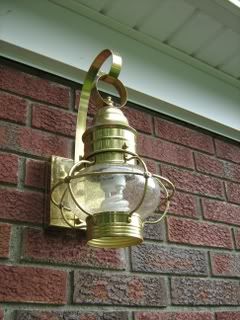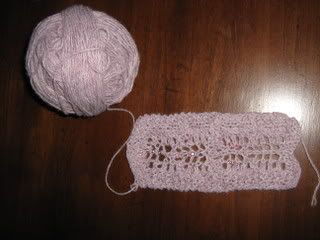Well, I still haven't finished anything (funny how adding to the number of WIPs does that), and I'll be off-line traveling for the next week, so I thought I'd leave you with a fun story I've been meaning to post from the DIY file.
Once upon a time, the light outside my front door burned out. I kept forgetting and forgetting to change it in the daytime (I don't need to turn on the outdoor light when it was day). But finally I resorted to putting a reminder on my to-do list. So eventually on a sunny Saturday afternoon, I took a new bulb and went out to change it.
And of course it's the kind that has the shade screwed on, so I needed a screwdriver. This should not have been difficult. We have at least two large ones (the smaller ones didn't work- I couldn't get enough leverage). I found numerous other lost tools, including the drill bits (put up three shelves and rehung the doors to the wardrobe, which were taken off to move it during construction), the roundover bit for the router (which I needed for the last custom door), the power planer, which we needed to level the last set of bookcases, and both hand planes (which I didn't need for anything in particular, but should have been on a shelf and not on the floor under a bunch of other crap).
Finally, I went out and bought a new one. Because, really, that's the only surefire way to find a lost tool- replace it. So, I took my brand-new screwdriver and approached the light. Insert blade A into slot B. Twist. Twist harder. I went in and got a chair to stand on so I could get better leverage. I'm not exactly a fragile flower- I'm tall and fairly strong, and I leaned on that screwdriver hard enough to worry about bending the fixture. And still nothing moved. No amount of leverage, no amount of WD-40 on the screws would make the slightest bit of difference. I tried other tools. Nothing. The screws were rusted solidly into the mass. Then I took a closer look at the fixture itself. Rust everywhere. There were even holes rusted through the top. Really it was kind of surprising the area of fixture around the screw hadn't just disintegrated when I tried to get the screws out.
It then occurred to me that that the light itself was probably original to the house (making it 41 years old), and the bulb had probably not been changed in at least eleven years. Why eleven? I'd never changed it before, and I'd been there five years. And the prior owners didn't use the front door (I know, I had to hack through a lot of brush to even find it). And they had the place six years. That put it back to the people before them.
So, now what?
I decided to forget about the screws holding the lampshade on and just dismounted the whole light from the front of the house. Then I went back to the hardware store, and bought a replacement for the whole unit, carefully selecting one that used the same pattern of mounting holes (because the front facade of the house is brick, and I did not want to have to set a new bracket). Naturally the plain inexpensive fixtures all had the wrong sort of mounting hardware, but at that point I just wanted the job done.
So I came home, installed the new lamp. Screwed in the new bulb. Compact fluorescent, so I won't have to worry about it for another eleven years, at least.
The missing screwdrivers turned up several months later. I'm still not speaking to them.
And, as it turns out, it only takes one engineer, three weeks, $60, and a lot of swear words to change a light bulb....



